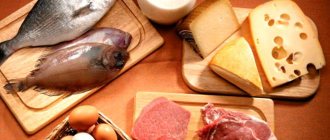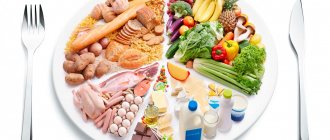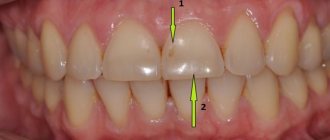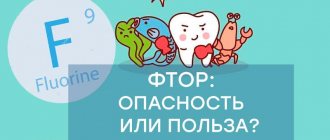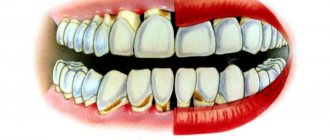general characteristics
Fluorine is a reactive, poisonous gas with a pungent odor. It may be pale yellow or green-yellow in color. At very low temperatures (from -190 to -290°C) it turns into crystals or liquid.
The element belongs to the halogens, substances that, interacting with metals, form salts. In addition, it is capable of reacting with almost the entire table of chemical substances, destroying them upon interaction.
The presence of this element was first suggested in the 18th century, but attempts to extract it from compounds ended in injury or death to scientists. It was only at the end of the 19th century that Henri Moissan was able to do this. On the one hand, fluorine is a dangerous element, but on the other hand, it is extremely necessary for most living organisms and humans. It is found in ores and minerals in the earth's crust, and in the form of compounds in underground and sea waters.
Biological role of fluorine in the human body
Fluorine performs some of the most important functions in the human body . Namely:
- regulates metabolism;
- plays an important role in the process of formation of the entire bone skeleton even during intrauterine development;
- in case of a fracture or crack of a bone, it accelerates the fusion of its tissues;
- in combination with calcium and phosphorus, it forms the basis of tooth enamel;
- has a beneficial effect on the circulatory system;
- increases immunity;
- promotes the removal of heavy metals, radionuclides and other dangerous substances for the body.
About 60-65% of fluoride enters the body through drinking water, and less through food. If its content in water does not exceed 5 mg, then sodium fluoride is added to it. It is very difficult to maintain the optimal amount of fluoride for the body, since the border between its norm and excess is too small. If a person needs only 1-3 mg of this substance per day, then the slightest excess of this norm can turn the useful element into a potent poison.
Fluoride absorption
When fluoride enters the human body, it is retained through the bloodstream in the intestines or stomach. The degree of absorption directly depends on its solubility in water and the amount of water consumed. Most of the soluble fluoride is absorbed through the walls of the gastrointestinal tract.
Calcium, phosphorus, magnesium and aluminum can reduce the degree of absorption. Absorption also occurs through fluoride-containing toothpaste and the respiratory tract if the element is a gas.
Almost all fluoride is found in teeth and bones. The degree of its concentration depends on the age and gender of a person, as well as the state of his skeletal system. The element is excreted through urine. In children, more than 80% of fluoride is retained, in adults less - about 60%.
Find out which products contain fluoride: table and description
Fluoride is found in all organs and tissues, but 96% of it is concentrated in bones and teeth.
Together with calcium and phosphorus, it ensures the mineralization and strength of the skeleton, the maturation and hardness of tooth enamel, participates in the growth and healing of bones during fractures, and improves the absorption of iron, which is important in the formation of hemoglobin. Which foods contain a lot of fluoride will be described below.
The mineral promotes normal hair and nail growth, takes part in important physiological cycles, strengthens the immune system , prevents the absorption of magnesium and iodine (which increases muscle contractility), removes heavy metals, toxins, radioactive nuclides, and binds free radicals.
Thanks to the microelement, the vital activity of acid-forming bacteria is suppressed, causing the acidity of the mouth and stomach to decrease.
Contrary to popular belief, fluoride does not prevent the development of caries, but stops it.
ATTENTION . Recently, it has been believed that this element is destructive. When the body is fluoridated, intelligence decreases, enzymes are destroyed, the central nervous system, intellectual activity of the brain, and the immune system are destroyed.
Grocery list
Let's figure out where and what fluoride is contained in, in what products. A third of the fluoride in the body comes from food, but most of it is supplied by water .
Since the natural trace element is in a bound state (in the form of fluorides), its concentration in living organisms is negligible. The exceptions are tea and sea fish.
You will find out which other foods contain the most fluoride from the table below.
A significant part of the element is lost during cooking. When cooking in aluminum cookware, it interacts with the material of the pan and is thus removed from the food.
REFERENCE . Water from natural sources contains from 3 to 12 mg of fluoride ions. To get a daily dose of this element, you need to eat 3.5 kg of bread!
It is impossible to cover the deficiency of a microelement with a monotonous diet, so doctors do not prescribe a diet, but fluoride-containing medications.
Vegetable origin
Products containing large amounts of fluoride:
- cereals (bran, sprouted grains, rice, buckwheat, whole grain flour, oatmeal, rolled oats);
- vegetables (pumpkin, potatoes, onions, seaweed, avocado, asparagus, Brussels sprouts, turnips, cauliflower, tomatoes, carrots, cucumbers, lettuce, other leafy vegetables);
- fruits (grapefruit, dates, apples);
- tea (black and green);
- wine, grape, tomato, orange juices;
- honey;
- prunes, almonds, walnuts, sunflower seeds;
- spices and herbs (parsley, cumin, lemongrass, beet tops, dandelions, spinach, garlic, seaweed);
- pickles (pickles).
The source of fluoride in wine is a chemical that was sprayed onto the grapevine. Its concentration can go off scale, so you should approach this drink with caution .
REFERENCE . The daily requirement of the microelement will be provided by eating 300 g of walnuts.
Fluoride ions have the ability to move from the leaves into the solution, so when tea and decoctions are infused, 70-90% of it migrates into the water. Chamomile “gives up” the least amount of minerals – 5%, rosehip loses 20%, mint – 30%.
Animal origin
Fluorides are most concentrated in the following animal products:
- meat;
- liver;
- broths made from bones, poultry or canned fish;
- milk;
- fish;
- seafood, shellfish (oysters).
700 g of salmon or 20 liters of milk will cover the daily requirement for the microelement.
ATTENTION . It is better to cook fish with bones: this will provide the body with more fluoride than just fillet.
Table of Contents
The level of micronutrients in different products varies widely.
Table 1. Fluoride in food
| Product | per 100 g, mcg | Average % of daily value for an adult |
| tea (black, green, white) | 10 000-20 000 | 628,5 |
| mackerel | 1400-3000 | 92 |
| tuna (fresh and smoked) | 1000-2000 | 63 |
| mineral water | 800-1500 | 48 |
| cod, blue whiting, pollock, hake | 700-1400 | 44 |
| Walnut | 685-1300 | 41 |
| haddock | 500 | 20,75 |
| horse mackerel | 490-1000 | 31 |
| smelt, flounder, rudd, lenonema, bream, bluefish, mackerel, whitefish, salmon (salmon), trout, crayfish, scallop, white-eye, grass carp, spicy sprat, red-eye, lethrin, mullet, chum salmon, crucian carp, pink salmon, ruff, capelin | 430-900 | 28 |
| oyster | 340-860 | 25,25 |
| pork, lamb | 150-300 | 6,5 |
| chicken | 140-280 | 9,6 |
| chicken egg | 90-180 | 6 |
| buckwheat and semolina, milk, pasta, potatoes | 50-100 | 3,125 |
| beef | 16-32 | 1,025 |
| powdered milk, pecans | 10 | 0,425 |
| radish | 6-12 | 0,3875 |
| carrot | 3-6 | 0,2 |
REFERENCE . Fluorides are most fully absorbed from drinking water.
Why fluoride is important: norm, deficiency, excess
The lack of fluoride ions does not have pronounced symptoms, so people seek medical help late.
Lack of the element causes destruction of bone tissue, increased sensitivity of teeth, which entails erosion, fragility and brittleness of nails, hair loss, split ends, anemia, osteoporosis, curvature of the spine, periodontal disease, caries, and blurred vision.
The element is poisonous when taken in excess of 20 mg, so an overdose is dangerous to health.
With an excess of the element, growth slows down, cell division stops, general weakness, drowsiness, nausea, vomiting, skin rash, whispering, complete loss of voice, convulsions, trembling fingers, bleeding gums, depression of the kidneys, liver, thyroid gland, and thinking ability are observed. Breathing becomes difficult, blood pressure decreases, bones become rough, causing muscle and joint pain.
Fluoride poisoning leads to the development of conjunctivitis, lacrimation, pneumonia, irritation of the bronchi, skin, severe abdominal pain, diarrhea, and coma.
Excess fluoride is fraught with fluorosis - a disease in which gray-brown spots appear on the enamel, joints become deformed, become knotty, and bone tissue is destroyed, wrinkles and white hard areas appear on the skin.
Fluorosis develops in the presence of 0.5 mg of fluoride per 1 kg of body weight.
IMPORTANT . Symptoms of overdose appear gradually, so if you feel the slightest discomfort, you should consult a doctor.
If medical care is not provided in a timely manner, treatment may be delayed for a long time.
To eliminate excess fluoride ions, it is necessary to consume calcium-containing foods and medications (calcium gluconate), as well as laxatives (sodium sulfate). Magnesium-based medications interfere with the absorption of the mineral. In case of poisoning with this trace element, you need to induce vomiting and rinse the stomach.
CAREFULLY . 3 mg of fluoride per 1 kg of food is enough to cause poisoning. If the dose of the incoming element is 10 mg, then the skeletal tissue is destroyed. When the microelement content is 5 mg per 1 liter of water, oncology occurs. If 5 g of fluoride is consumed, death occurs.
Fluoride is indispensable for the formation of bone tissue and teeth, but a small excess of it leads to very serious irreversible consequences. A deficiency of this microelement causes much less damage to the body, so there is no need to control the fluoride content in food.
{title}>LiveJournal
Beneficial features
Benefits of fluoride for teeth and bones
Fluoride plays an important role in the formation of bones, dentin and tooth enamel. It and its compound (fluoride) are present in the human body: teeth, bones, skin and thyroid gland. Without this microelement, the formation of healthy teeth is simply not possible; in addition, it protects teeth from various diseases, including caries. If a pregnant woman's diet contains the required amount of fluoride, this is the key to strong teeth for her, as well as the teeth of her unborn baby.
The optimal amount of fluoride benefits the entire human skeletal system. It helps strengthen bones and reduces the risk of various degenerative processes, and also has a beneficial effect on wound healing and improves iron absorption. For optimal functioning of the human body, a balance of vitamins and microelements is necessary. This also applies to fluoride; its deficiency or excess can have extremely negative consequences.
Find out how activated carbon cleanses the body. All information about the benefits, use and dosage of activated carbon.
The human body is not capable of producing such a macronutrient as sodium. Read here what products it contains and how it affects our body.
Iodine
The main function of iodine is to ensure the synthesis of the thyroid hormone called thyroxine. In addition, iodine is actively involved in the creation of phagocytes, which are a kind of “patrol” cells that destroy debris and all kinds of foreign bodies directly in the cells.
© ddukang/Getty Images
Benefits of iodine
- Normalization of the endocrine system by regulating the functions of the thyroid gland, as well as the pituitary gland.
- Ensuring metabolic processes.
- Promoting normal physical and mental development (especially in children).
- Prevention of accumulation of radioactive iodine, which provides reliable protection against radiation exposure.
- Strengthening the immune system.
- Normalization of the nervous system.
- Regulation of the cardiovascular, reproductive, and musculoskeletal systems.
- Stabilization of hormonal levels.
Important!
Iodine in its pure form that enters the body is almost not absorbed, and significant doses of it can provoke severe poisoning: for example, the lethal dose of pure iodine for humans is about 3 g (it is impossible to obtain such a dose with food fortified with iodine).
Excess iodine has the following consequences:
- the development of hyperthyroidism, one of the manifestations of which is Graves’ disease with goiter;
- increased irritability;
- tachycardia;
- muscle weakness;
- sweating;
- sudden weight loss;
- tendency to diarrhea.
Iodine deficiency leads to the following disorders:
- diseases of the nervous system;
- growth retardation and development of dementia in children;
- diseases of the thyroid gland;
- increased risk of developing cancer;
- increased cholesterol;
- congenital malformations;
- miscarriage in women and sterility in men;
- decrease in heart rate.
Iodine enters the human body with food, water and air, so people who permanently live near the sea rarely experience iodine deficiency, especially if they include iodine-containing foods in their diet.
What foods contain iodine?
The daily requirement of iodine is 2 - 4 mcg per kilogram of body weight.
© Aleksandr Kichigin
Golden Rule!
The less iodine is present in the environment, the more foods rich in this microelement need to be introduced into the diet.
Iodine-containing products:
- sea salt;
- green vegetables;
- table iodized salt;
- ocean and sea fish;
- seafood, including seaweed and seaweed;
- onion;
- garlic;
- pineapples;
- eggs;
- Cod liver;
- oriental spices (especially ginger, pepper, coriander, as well as cumin, cloves and turmeric);
- turnip;
- asparagus;
- carrot;
- cabbage of different varieties;
- potato;
- tomatoes;
- beans;
- cereals;
- grape;
- strawberry;
- beet.
Lack of fluoride in the body
The body's lack of this element is mostly due to its small amount in water - less than 7 mg per liter. Other reasons :
- metabolic disease;
- missing intake through other sources: food, toothpaste.
If the body regularly lacks fluorine and its compounds, it may occur:
- osteoporosis. This is a disease in which bones become thin and brittle as a result of resorption of bone substance.
- Caries. A dental disease that is accompanied by tooth decay. It begins with the dissolution of minerals with further destruction of tissue and the formation of a cavity.
Excess
Most fluorine compounds are poisonous. Its toxic dose for the human body is 20 mg, and even 2 g will cause death. In case of acute intoxication of the body, damage to the central nervous system and digestive tract may occur.
Main symptoms
- nausea;
- stomach upset;
- vomit;
- muscle spasms;
- low blood pressure.
In chronic poisoning, which is caused by regular consumption of water with a high fluoride content, destruction of tooth and bone tissue, metabolism and deterioration of blood clotting occurs. In addition, it increases the risk of osteosarcoma.
Main reasons:
- regular intake of various fluorine compounds into the body at work;
- improper exchange of fluoride in the body;
- increased fluoride content in drinking water;
- overdose of medications that contain this element.
Consequences of excess fluoride:
- deterioration of tooth enamel;
- osteoporosis;
- calcification of ligaments and tendons;
- the appearance of chalky stains on the teeth;
- the appearance of bone spurs;
- low blood pressure;
- worsening heart rhythm;
- skin irritation, itching and peeling;
- loss of voice;
- the appearance of a dry cough;
- bleeding from the mouth or nasal cavity.
Silicon
Despite the fact that silicon is present in the blood in fairly small quantities, when its reserves decrease, a person begins to react sharply to weather changes (this can include mood swings, severe headaches, and a deterioration in mental state). In addition, a deficiency of this element negatively affects the condition of the skin, hair and teeth.
© onlyfabrizio
The benefits of silicon
- Ensuring calcium metabolism.
- Preserving the strength of teeth.
- Promoting the elasticity of vascular walls, tendons, muscles.
- Strengthening hair.
- Reduced development of skin diseases.
- Normalization of the nervous system.
- Improving heart function.
- Ensuring normal bone growth.
- Enhanced calcium absorption.
- Improved brain functioning.
- Normalization of metabolism.
- Stimulation of immunity.
- Reduced blood pressure.
- Strengthening connective tissue.
- Slowing down the aging process.
Excess silicon in the body is caused by occupational hazards of workers involved in industrial enterprises working with cement, glass, and asbestos.
What foods contain silicon?
The daily requirement of silicon, which is fully satisfied through a balanced diet, is 20 – 50 mg. However, in the presence of osteoporosis, cardiovascular diseases, as well as Alzheimer's disease, it is necessary to increase the consumption of foods containing this trace element.
© zstockphotos
Food sources of silicon:
- rice;
- oats;
- barley;
- soy;
- legumes;
- buckwheat;
- pasta;
- corn;
- Wheat flour;
- cereals;
- nuts;
- grape;
- eggs;
- fish caviar;
- mineral water;
- green vegetables;
- Jerusalem artichoke;
- potato;
- bulb onions;
- seafood;
- radish;
- seaweed;
- dairy products;
- beet;
- bell pepper;
- seeds;
- meat and offal;
- mushrooms;
- carrot;
- berries;
- apricots;
- bananas;
- cherry;
- dried fruits.
In addition, silicon is found in grape juice, wine and beer.
Foods containing fluoride
Fluoride in food
You can maintain the balance of fluoride in the body with the help of food. If there is not enough of this component in the water, then you should correctly adjust your diet from fluoride-containing products.
- Seafood. They contain a large number of microelements, including fluorine. It is worth thinking about eating shrimp, crabs, fish and its caviar, as well as seaweed.
- Black and green tea.
- Vegetables and fruits. Potatoes, apples and grapefruit are the richest in fluoride.
- Cereals: oatmeal, rice and buckwheat. Other cereals contain small amounts of fluoride.
- Red wine.
Selenium is a powerful antioxidant and is an element that boosts immunity. Let's find out what foods contain selenium - signs of its deficiency and excess.
Boost your immunity by hardening yourself in the sun. All about the benefits of solar hardening, how to start doing it.
Useful properties and contraindications when consuming lemon - https://ialive.ru/pitanie/poleznye-produkty/svojstva-polza-i-vred-limona.html.
Food sources
Fluoride contains: asparagus, avocado, Brussels sprouts, carrots, cumin, cauliflower, cucumbers, dates, lemongrass, parsley, turnips, beet tops, dandelions, sunflower seeds, garlic, spinach, tomatoes, green leafy vegetables, nuts (especially almonds) , turnip, seaweed.
By the way, it is interesting that fluorine has the ability to “migrate” into water, which is especially useful for decoctions and teas.
For example, when black tea is brewed, approximately 70-90 percent of the fluoride passes from the leaves into the liquid. Approximately 30% of the mineral contained in mint is released, approximately 20 percent is released from rose hips, and chamomile provides only 5% of the useful microelement. Table of fluoride content in some products
| Product (200 g) | Fluoride (mg) |
| Tea (black, green, white) | 20 |
| Mackerel | 3 |
| Tuna | 2 |
| Mineral water | 1,5 |
| Hake | 1,4 |
| Pollock | 1,4 |
| Cod | 1,4 |
| Blue whiting | 1,4 |
| Walnuts | 1,3 |
| Horse mackerel | 1 |
| Flounder | 0,9 |
| Sea bream | 0,86 |
| Mackerel | 0,86 |
| Salmon | 0,86 |
| Trout | 0,86 |
| Cancer | 0,86 |
| Scallops | 0,86 |
| Oysters | 0,86 |
| Mullet | 0,86 |
| Lamb meat | 0,3 |
| Pork | 0,3 |
| Bird | 0,28 |
| Chicken eggs | 0,18 |
| Buckwheat | 0,1 |
| Semolina | 0,1 |
| Milk | 0,1 |
| Potato | 0,1 |
| Pasta | 0,1 |
| Beef meat | 0,032 |
| Radish | 0,012 |
| Carrot | 0,006 |
Fluoride-rich foods
The largest amounts of this element are found in tea, sea fish, walnuts, bran, eggs, meat and seafood. Among the cereals, it is worth highlighting oatmeal, buckwheat and rice. Plant-based foods also contain fluoride compounds: all green leafy vegetables, grapefruit, apples, onions.
Table - Foods rich in fluoride
| Products | Fluoride content (mg) |
| Sea fish (serving 150 g): | |
| Cod | 0,105 |
| Sea bass | 0,210 |
| Herring and mackerel | 0,525 |
| Freshwater fish (150 g serving): | |
| Acne | 0,240 |
| Salmon | 0,870 |
| Fish products (serving 45 g): | |
| Cold and hot smoked herring | 0,160 |
| Salmon | 0,200 |
| Dried cod | 0,225 |
| Herring in tomato | 0,960 |
| Poultry meat and offal (serving 150 g): | |
| Chicken fillet | 0,210 |
| Chicken liver | 0,29 |
| Bread (serving 60 g): | |
| Grain bread | 0,100 |
An excess of fluoride in the body through food and water can be traced in the event of causeless weakness and general malaise. In this case, you can limit the intake of this element by replacing apples with pears, seafood with meat, and tea with cocoa. The main thing to remember is that everything is good in moderation and find your optimal balance .
Cobalt
Cobalt is a component of vitamin B12, which is actively involved in vital biochemical reactions.
© Keikona/Getty Images Pro
Benefits of cobalt
- Increased hematopoiesis.
- Maintaining optimal hormonal levels.
- Normalization of pancreatic activity.
- Strengthening the immune system.
- Improving the absorption of iron in the intestines.
- Promoting cell and tissue regeneration after various serious illnesses.
- Strengthening the synthesis of proteins, without which normal functioning of the body is impossible.
- Promoting the formation of insulin.
A lack of cobalt in the body negatively affects the functioning of the nervous and circulatory systems. It must be said that deficiency of this element practically does not occur (the exception is vegetarians, whose diet does not include animal products rich in cobalt).
But you shouldn’t forget about an overdose of this substance, although it is only possible if you take medications and vitamin complexes containing cobalt incorrectly. In case of an overdose of cobalt, symptoms of toxic poisoning develop.
What foods contain cobalt?
The daily requirement for cobalt is about 40 - 70 mcg.
© bhofack2 / Getty Images Pro
Food sources of cobalt:
- dairy products;
- bread and offal;
- animal liver and kidneys;
- legumes;
- butter and ghee;
- eggs;
- corn;
- bran;
- sprouted wheat;
- cereals;
- cocoa;
- nuts;
- spinach (and leafy greens in general);
- rose hip;
- beet;
- fish;
- strawberry;
- strawberries;
- chocolate.
